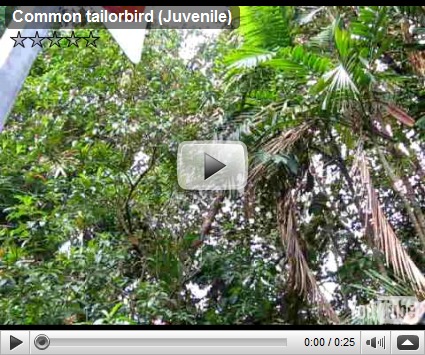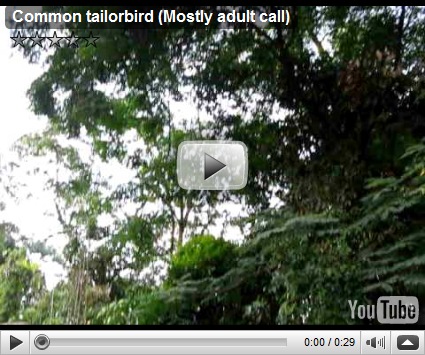lol… I just couldn’t resist putting that as the title when I recalled the image of Alvin, arms akimbo, announced “My kingdom!!” as he gave the neat black rows of budding seedlings a satisfactory onceover. ^__^ Then, as quick as it disappeared previously, the crimson sunbird dipped by and fluttered excitedly before finding its favourite spot on the crisscrossing pipes up above. Before I get you anymore confused, this place – with its sprinkler pipes and its daily stream of ‘customers’ – is none other than the NUS nursery. Set at about 5:30pm (give or take), the sprinkler turns on for approximately 15 minutes and the nursery immediately turns into ‘bird bathhouse haven’. Blimey, it was 4 lifers (refers to birds not seen before) in the span of 2 days; and literally under my nose too! I would probably have lil’ chance to catch and identify these 4 kinds of feathered fluffs under such close proximity if it weren’t for Wee Foong and Alvin respectively. *salutes* :)
It all started when I heard a firing of repeated chee-yup, chee-yup, chee-yup as I was heading down to the patch that I am currently shackled lock-and-key to (till they finish fruiting), albeit voluntarily.. heh. My ears strained and it seemed to be coming from the direction of the nursery. The source proved rather elusive as they tended to stop beneath the thick Dillenia leaves before becoming the blur specks that twittered and tweet away. Not till they flew and stopped near the nursery did I see it was a group of the not-so-common (from yours truly point of view) Common Tailorbird (Orthotomus sutoris). Ka-ching, ‘customer’ no. 1 is up~~
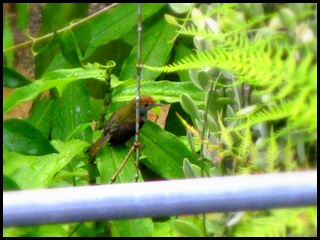 __
__
Limited to just hearing the explosive 2-syllable calls, I could only imagine that the Common Tailorbirds(Orthotomus sutoris) were enjoying a good soak from the sprinkling drizzle. From where I was standing, my view was limited by the black netting that cloaked the top of the nursery. Unless the birds came near the edges, I could only wait and hope while keeping a look-out for any other birds that might come near the nursery. And finally, after what seemed to be a long time, a chestnut head popped into view (left). Preening itself and fluffing its wings dry, the tiny twitter hopped from one broad leaf to another before taking off towards the secondary forest behind.
After an hour or so, I decided to move along (though rather reluctantly) to check out the Melastoma patch. And it seemed that there was a flurry of activity going on about the area (picture at top right). Going in for a closer look brought this tiny chick into view… oh my god, isn’t that just the cutest thing ever?! Puffed up like a toasted marshmallow, the lil’ critter was going cheet-cheet-cheet… while waiting for its parents to show up with food. And whaddya know, the parents were none other than the Common Tailorbird. Sweet!!
It was definitely a real treat as this was the first time seeing a family of Common Tailorbirds on the Melastoma patch which I have picked to observe the fruiting phase of the plant. But nothing good last long, and true enough a walking couple and a passing car soon sent the skittish family to the top of a nearby petai tree. In this video, the adult’s pit-chik, pit-chik, pit-chik intermingled with the younglings’ cheet, cheet, cheet.
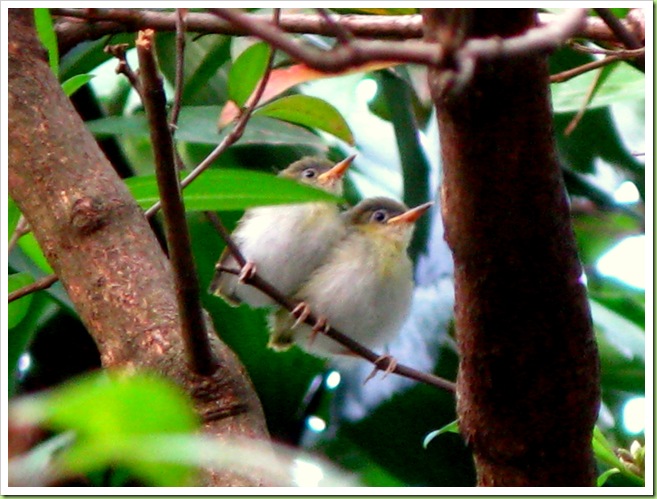
And my favourite picture by far, a snapshot of the cherubic babies. I can almost hear the fangirl within me squealing~~ Luckily for you and me, she doesn’t come out often… =). Tailorbirds get their name from the way its nest is constructed. As its namesake suggests, this lil’ birdy uses its needle-like bill to pierce the edge of a large leaf before sewing them together with plant fibre/spider web to form a cradle. And within its snug comfort, the actual grass nest is put together [1]. Although Junior 1 and Junior 2 were perched atop a Melastoma tree, they were fed with stuff that weren’t plucked from the tree. In fact, the parents flew away from the patch before returning 5 minutes later to soothe the hungry calls of their young. Like most warblers, Common Tailorbirds are insectivorous.
Just so you know, warblers are not particularly closely related, but share certain characteristics, such as being fairly small, vocal and insectivorous. :) Also, they tend to be more easily heard than seen. Being mostly brownish or dull greenish, identification can be difficult. But apparently, they can be told apart on the basis of song alone [2]. That certainly helps some.
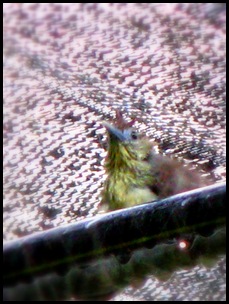 __
__
Not a very flattering picture, ‘customer’ no. 2 seemed to be thoroughly enjoying its fair share of drizzle. With a chestnut-brown crown and yellowish head-sides and underparts, the Striped Tit-babbler (Macronous gularis) is a chunky bird with a short bill. As its common name tit might suggest, it’s a small bird like the Tailorbird. And just like the Tailorbird, babblers are also insectivorous and rather vocal. Even so, tit-babblers are no Idol contenders. Their calls are usually a well-spaced chut-chut-chut-chut-chut (Song/Call courtesy of Xeno-canto/Asia):
…but then again, when the group of three (or maybe 4) flew into the sheltered nursery, their calls were more of a harsh chrrrt-chrr, chrrrt-chrr-chrri (Song/Call courtesy of Xeno-canto/Asia)… like so:-
Of course it’s never good to generalise for there are always an exception or 2. The chestnut-capped babbler (Timalia pileata) whistles a rather, supposed, pleasant tune [3]. It’s subjective of course.
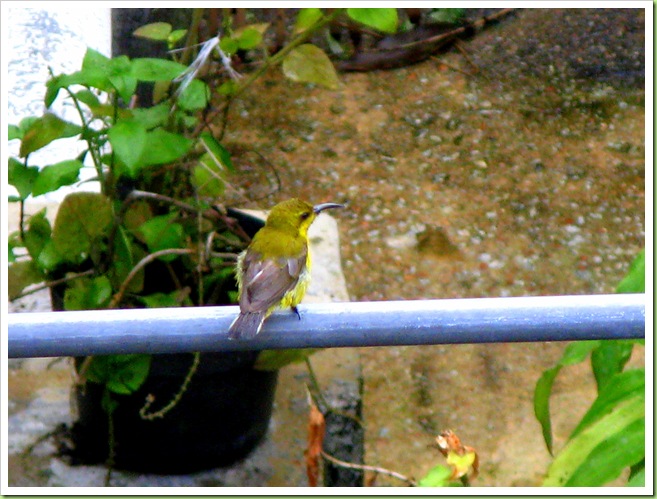
And irrashaimasu, it seems that ‘customer’ no. 3 is back! But this time, instead of the male, it’s the female Olive-backed Sunbird (Nectarinia jugularis) that made a visit. Unlike the resplendent male and his iridescent onyx-blue forehead, throat and breast, his mate sports a banana-yellow underside. As its generic name Nectarinia indicates, the Olive-backed feeds largely on nectar, though they do feed on insects and fruits. This also applies to sunbirds in general.
They bear similar resemblance to their counterparts in 2 very distantly related groups: the hummingbirds in the Americas and the honeyeaters of Australia. Due to convergent evolution as they share a lifestyle of nectar-feeding, their bills have evolved to be long, thin and curved while their tongues are brush-tipped and tubular. One other classic example of the convergent evolution is the wing. Both birds (Class Aves) and bats (Class Mammalia) can fly but the two are from completely different lineages after diverging from a non-flying common ancestor. Hence, even if hummingbirds, honeyeaters and sunbirds look like triplets side-by-side, the functional traits that are in charge of the processing of their water and sugar diet may vary [4].


Belonging to what might be considered as the most primitive of genera, ‘customer’ no. 4 – the Brown-throated Sunbird (Anthreptes malacensis) has a shorter and straighter bill compared to the long, thin and downcurved bill of the Olive-backed. So yes, besides having nectar and fruits on their menu, sunbirds like the Brown-throated feed chiefly on insects that scuttle about on leaves [5]. Derived from the word anthos (blossom) and threps- (nutrition), its generic name Anthreptes would therefore mean ‘flower-derived nutrition’. Probably a general description of the sunbirds’ diet. Probably.
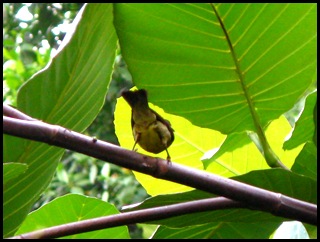 __
__
Perching high-up on a Dillenia stem, its wrick-wrick-wrick-wrick (as described by Craig Robson’s A Field Guide to the Birds of South-East Asia) or chick-chick-chick-chick (in my opinion ^^) rang out crystal-clear. Only at a certain angle did I catch sight of the bird trying to feast off the pods of the Dillenia fruit.
*Shout out to Hen: Brown-throated Sunbird eats Dillenia~~
And one thing that separates a sunbird from the hummingbird is that sunbirds cannot fly backwards unlike the latter. Both birds can hover over flowers [6], but the sunbird prefers to perch and feed compared to the buzzing hummingbird. Also, sunbirds live only in the Old World (Europe, Asia, and Africa) while hummingbirds reside in the New World (Americas and Australasia).
And last but certainly not the least, ‘customer’ no. 5 graced us with its presence. And it’s none other than the…
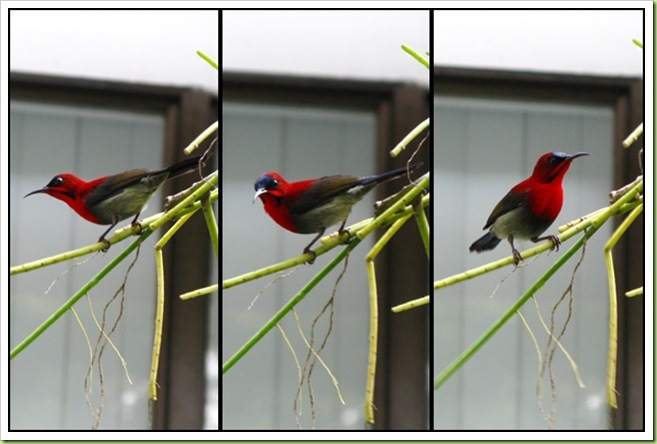
… Crimson Sunbird (Aethopyga siparaja)! Derived from the Greek word aithos (fire, flame) and –puge (rump, rear end), sunbirds of the genus Aethopyga are among the most brilliantly-coloured animals alive! Species of this genus also have short bills like the Brown-throated. But then unlike the Brown-throated, the bill of the Crimson is down-curved. From the middle picture, I can honestly say that the crown is blue. But based on the description found in the field guide, the males are said to possess an iridescent dark-green crown. And that’s why, when I saw it during the first of the 2 days, I thought this was the Temminck’s Sunbird (endemic to Sumatra)… feh. >_< That will teach me not to base everything solely on a book.
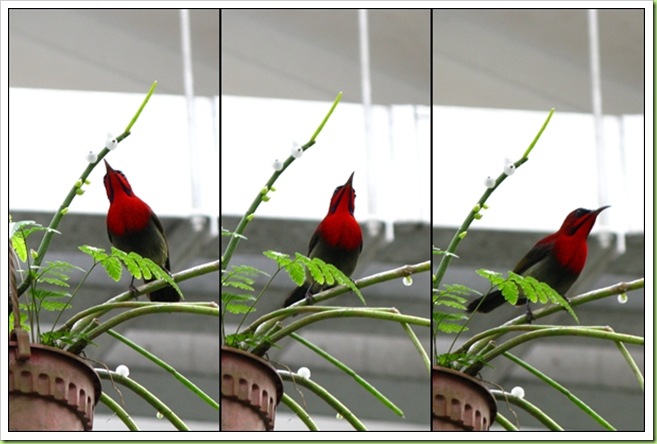
But anyway, I felt much better after the Crimson Sunbird stilled enough for me to get sharp shots of it. ^^v I can’t decide which I like best, so here they are. Hopefully, I can get a better shot of the Striped Tit the next time but once more, here’s my heartfelt thanks to Alvin and Wee Foong. Your jobs (or hobby, in WF’s case) rocks! ~(^∀^ )
Reference:
1. http://en.wikipedia.org/wiki/Tailorbird
2. http://en.wikipedia.org/wiki/Warbler
3. http://www.britannica.com/EBchecked/topic/597094/tit-babbler
4. http://jeb.biologists.org/cgi/content/abstract/206/4/659
5. http://animals.jrank.org/pages/1312/Sunbirds-Nectariniidae-PHYSICAL-CHARACTERISTICS.html
